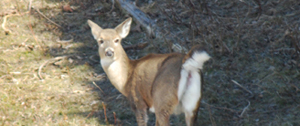
LYNDON — A deer hearing at Lyndon State College last week may have been lightly attended, but it still attracted hunters willing to cross knives with the Department of Fish and Wildlife.
“I think the deer herd has plummeted since the department took over the herd,” said Rodney Elmer from Northfield.
He said the Vermont herd, estimated at 130,000, would do better if biologists relied more on Mother Nature.
A hunter from St. Johnsbury aired his disbelief over estimates from department biologists that indicate the deer herd is healthy and growing.
“I seriously question where those statistics are coming from,” he said, adding that he has been seeing fewer deer.
He said he hunted every day of rifle season last year and saw 17 doe and only one buck.
Perhaps he would have enjoyed more success if he had hunted in Orleans County.
Recently, the department published its deer harvest report for 2012, showing that Orleans County was the hottest of spots among the three counties in the Northeast Kingdom.
Hunters there last year took a total of 1,151 deer over the course of four seasons involving archery, black powder, rifle and the special youth weekend hunt. That total far exceeded the 819 deer harvested in Caledonia County or the 231 that were taken in Essex County.
Statewide, the largest harvest of 2012 occurred in Franklin County, where just under 2,000 deer were taken.
The department’s deer project leader, Adam Murkowski, told only a dozen or so hunters last Wednesday night that the deer herd constitutes a robust population. He attributed the herd’s growth to back-to-back mild winters and a management plan intent on keeping the numbers of Vermont deer in balance with the habitat that supports them.
He said Vermont’s deer population has a fluctuating history, with numbers soaring when the winters are mild and plummeting when they are severe. Using a PowerPoint presentation of graphs and statistics, he showed how the harvest of bucks has stabilized since 2006.
Antlerless permits given out on the basis of deer density in any given zone, and the youth deer season weekend, were among the management tools he credited with bringing about that desired end.
Still unknown are the effects global warming will have on the herd. Warmer winters suggest that the herd’s population is likely to grow. But if the herd gets larger, will the state have the habitat to support it?
The ten-year West Mountain Wildlife Management plan is coming up for its renewal. Public hearings will be held on June 11 in Brighton and June 13 in Lyndon to review how the state has been managing the 22,000 acres that were acquired, mainly through the Champion Lands deal of 1991.
Mark Scott, the department’s director of wildlife, told hunters last week the department is counting on public involvement to both preserve and improve wildlife habitat.
The habitat statewide is changing, and Mr. Murkowski noted the pressure is on to keep harvest levels stable while maintaining a healthy herd.
Among the hunters present, Mr. Elmer expressed fears that the big deeryards that were crucial to the herd’s survival are disappearing. He attributed part of the decline to the way the forest is being managed, opining that hardwood is pushing out the cedar and spruce stands that deer need to survive.
“We want what’s right for the land and what’s right for the deer,” he said. “If we try to grow a bigger herd in the Northeast Kingdom and the land won’t support it, that’s a bad move.”
The hearing last week was the fourth in a series held by the department on the status of the Vermont deer herd. The fifth and final one will be held on June 5 in Manchester.
contact Paul Lefebvre at [email protected]







